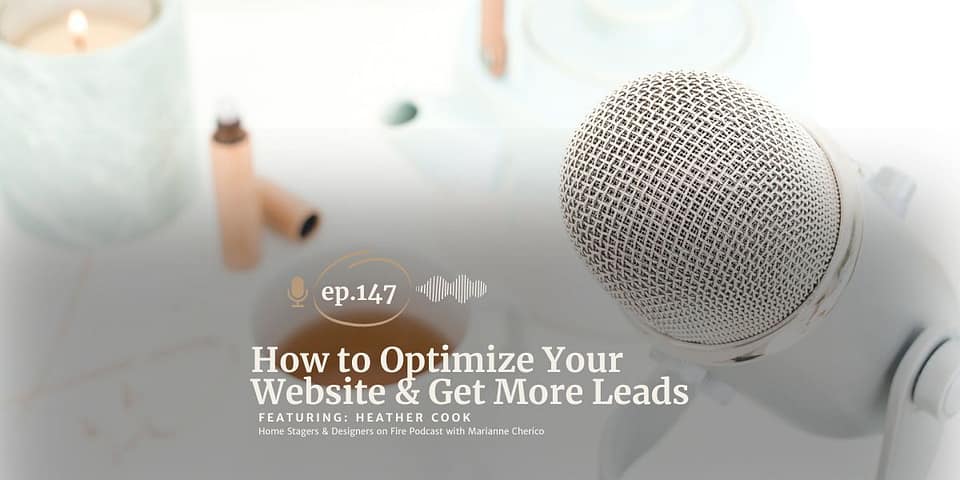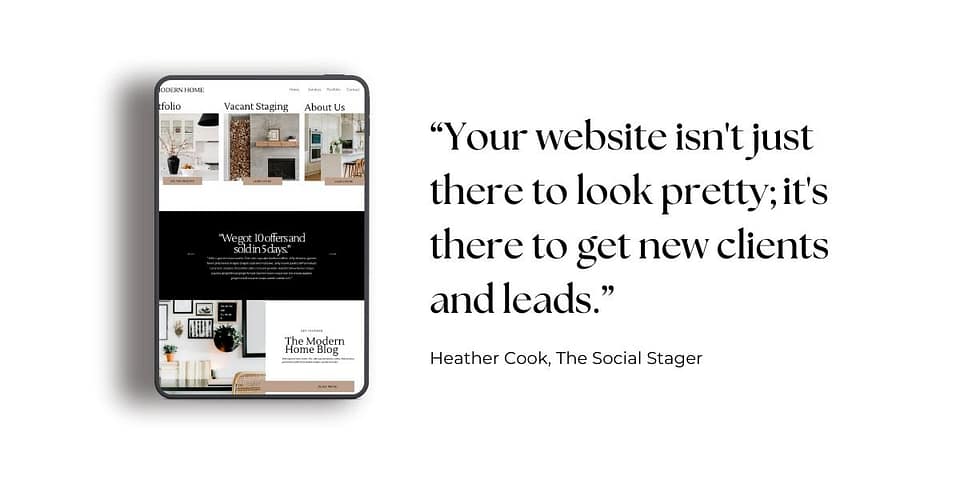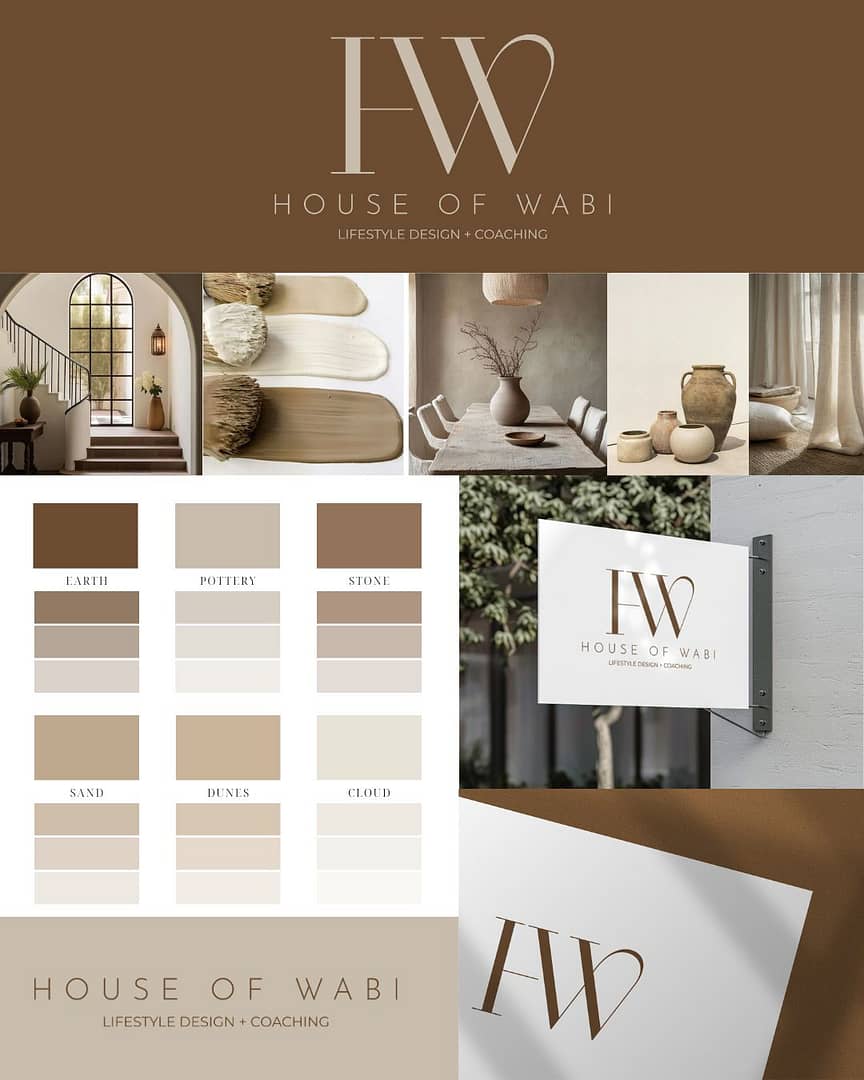When it comes to getting leads for your home staging business, your website is your #1 marketing tool. It works in the background, building brand awareness about your business, and should act as the top lead generation tool for your business. Your website isn’t just there to look pretty; it’s there to get new clients and leads. If it’s not doing that, it’s time to make changes.

As I covered in my previous article, there are many ways you can optimize your website to get more leads. Strategies like improving your landing page, showcasing the results of your staging services, and making your copy more scannable are key ways to enhance your website.

There’s still more you can do if you want to boost your website’s performance and increase the number of leads you get from it. Here are five more strategies that will help you boost website visibility, build trust with prospective clients, and build a thriving staging business. Let’s dive in.
1. Share Your Process and Pricing to Build Trust
If you want more clients to trust you, sharing your pricing is the first step. I understand that some home staging companies choose not to share pricing for various reasons, but that’s a mistake.
Being open about your prices and process helps prospective clients make informed decisions about whether or not to use your services. The more open you are, the more trustworthy you seem. This strategy is also great for weeding out people who aren’t a great fit for your services and attracting those who are.
Here’s how I recommend you do this:
- Share Your Staging Process: Clearly outline how you work in a step-by-step process. Share what it looks like to work with you from start to finish. By doing so, you help prospective clients understand what they can expect when they work with you.
- Outline Your Pricing: Even if your services are customized, offering starting prices or price ranges gives potential clients a baseline understanding. Including sample projects with associated costs can further illustrate your value.
- Feature FAQs: Address common questions about your services and pricing in a dedicated FAQ section to alleviate client uncertainties preemptively.
By openly sharing this information, you position your business as trustworthy and client-focused, encouraging more inquiries and leads.
2. Design a Compelling Portfolio Page
Let’s face it: your portfolio matters if you’re a home stager or interior decorator. A well-designed portfolio page is key to showcasing your expertise and building trust with your visitors.

If you want to make the most of this critical page on your website, here are some tips to help you show off your work:
- Incorporate Before-and-After Galleries: Highlight your expertise by sharing powerful before-and-after examples of your work.
- Include Case Studies: Curate a few of your most impressive projects as case studies. Include details like what changes you made, challenges your staging helped overcome, and the results.
- High-Quality Images: Use professional-quality photos to present your work in the best light.
A strong portfolio attracts potential clients and gives them the confidence to choose your services.
3. Optimize Your Website for SEO with a Blog
Improving your website’s visibility on search engines is essential for attracting organic traffic. One of the most effective ways to do this is by building a blog with SEO-optimized content. Regularly publishing high-quality, keyword-rich blog posts establishes you as an industry expert and helps improve your search engine rankings.
Additionally, addressing common staging-related questions and providing valuable insights will help your website attract more organic traffic and convert visitors into leads.
Moreover, I recommend implementing these SEO strategies:
- Keyword Integration: Research and incorporate relevant keywords like “home staging business” into your website copy and image alt text.
- Incorporate Location-Specific Keywords: Optimize your website by choosing keywords that include the city or areas you service in your copy, meta tags, and page descriptions. This will help you rank higher in local searches.
- Meta Tags and Descriptions: Write compelling meta titles and descriptions that accurately reflect your content and include target keywords.
- Mobile Optimization: Make sure your website is mobile-friendly, as search engines prioritize mobile-responsive sites.
These efforts can significantly enhance your online presence, making it easier for potential clients to find you.
4. Optimize Website Forms for Higher Conversions
User-friendly forms are vital for capturing leads effectively. Too many home staging websites make these forms overly complicated or don’t use them effectively. Naturally, this results in fewer inquiries and impedes you from getting leads. If you want prospective clients to contact you, you need to make it as easy as possible for them to do so.
To optimize your website forms, here are a few key tips:
- Simplify Form Fields: Ask only for essential information to reduce friction and encourage completion.
- Offer Incentives: Provide value, such as a free quote or free resource, in exchange for form submissions.
- Set Clear Expectations: Inform users about what will happen after they submit the form to build trust.
A well-designed form makes it easy for people to reach out to you. Because of that, you’re more likely to get more inquiries and increase the chances of landing new staging jobs.
5. Provide Clear Calls to Action (CTAs)
Effective CTAs tell people exactly what to do to get their desired results. As I have said before, people need to know what action to take to work with you. If your website doesn’t provide clear, actionable, and aligned CTAs, then you won’t get leads. It’s really that simple.

I recommend including both primary and secondary CTAs on your website. Primary CTAs will very clearly ask visitors to take a specific action like “book a staging consultation” or “get a free staging quote“. Secondary CTAs are great for building your email list with prompts to sign up for your newsletter or opt-in for a freebie.
Here are my tips for creating compelling CTAs:
- Use Action-Oriented Language: Tell people what to do with phrases like “Explore our Services” or “Get a Free Staging Quote”. Use action words like “start, discover, explore,” etc.
- Strategically Place CTAs: Position your CTAs throughout your website. Highlight primary CTAs at the top of your website pages. In contrast, secondary CTAs should be positioned towards the bottom or as an opt-in that pops up as the visitor scrolls.
- Emphasize the Benefits of Working with You: Your clients want to know what’s in it for them. Emphasize the value of your services and what they will get by working with you.
Getting your CTAs right dramatically boosts the likelihood that prospective clients will do more than scroll through your website.
Getting Leads Online: Create a Website that Converts
By implementing these additional website strategies, you’ll improve the effectiveness of your website at getting leads. As a result, your website will become your #1 resource for building brand awareness and attracting new clients.

Not sure how to optimize your website to get more leads and attract your target audience? Get our expert help with a website audit. We’ll do a deep dive on your website to see exactly what’s standing between you and more client inquiries.
If you want to create a beautiful website that functions as a strong lead-generation tool, we’d love to help. My website design services are tailored to helping home stagers create a professional and effective online presence that helps them build a thriving business.





